
BIOLOGY
EXTERNAL ANATOMY
Sea stars are among the most conspicuous of all the invertebrate animals, having a distinctive flattened body basically in the form of a star. Found only in marine environments, these free-living creatures exhibit radial symmetry, generally based on a five-pointed star. Of course there are many exceptions: certain sea stars have six or even more arms. Heliaster kubiniji, found in the Panamic region, may have up to 50 arms, believed to be the most of any sea star.
The body of a sea star is generally flattened and at least somewhat flexible. The internal skeleton is comprised of very numerous separate calcareous pieces bound together by connective tissue and often bearing spines, plates and tubercles. The arrangement and structure of these calcareous elements is the principal diagnostic tool in the identification of a sea star. Although most sea stars appear quite rigid, specialized connective tissue enables them to become surprisingly supple when necessary, especially when attacking prey, fleeing predators or when righting themselves after having been flipped upside down.
Situated on the upper (aboral) side of a sea star are the central anus and the madreporite, a circular calcareous sieve located just off centre. The mouth is located in the centre of the under (oral) side of the body at the centre of open furrows called ambulacral grooves. These structures run the length of each arm and are where the tube-feet are located.
Although sea stars lack developed eyes, they do have "eye spots" complete with a simple lens located at the tip of every arm. These eye-spots are light-sensitive and it has been shown that certain species are drawn toward while others shun light. Scattered over the skin of sea stars are neurosensory cells which are highly sensitive to both touch and chemical tastes. These are especially numerous in the suckers of the tube-feet, where they are incredibly dense, up to 70,000 per square millimetre!
With the aid of a magnifying glass, many minute but exquisite details can be seen on the skin of sea stars. Many species have tiny calcareous pincers called pedicellariae, usually situated in clusters or in wreaths surrounding spines. Variously shaped, pedicellariae may look like forceps, bird beaks, or even bivalve clams. These mini-pincers are extremely effective at deterring predators and keeping the surface free of parasites and fouling organisms. Also scattered over the surface are clusters of tiny finger-like protrusions of the body wall. These thin-walled gills protrude between the skeletal plates, serving to exchange respiratory gases and excrete liquid wastes.
INTERNAL ANATOMY
For an amazing animation of sea star anatomy, visit https://vimeo.com/37417009
Inside the skeleton of a sea star lie the internal organs, including the water vascular system, digestive tract, reproductive organs and nervous system. Controlled by an internal plumbing mechanism called the water vascular system, the tube-feet can be employed in a coordinated fashion, enabling the animals to move about and grasp prey. Open to the sea via the madreporite, the water vascular system uses muscles and hydraulic pressure to operate the tube-feet. When fluid is withdrawn the tip of a tube-foot creates suction, enabling the sea star to cling to a rock, climb a piling or grip prey. Individually these suckers are not especially strong, but when used in concert they can apply a surprisingly powerful force. While most species possess tube-feet that terminate in suckers, the sand star, found on soft substrates, has bluntly pointed ones.
The digestive system occupies much of the space inside a sea star. The mouth opens into two stomachs that are connected to paired, lobed organs called pyloric caeca that extend into each arm. These organs secrete digestive juices and also serve for dissolved food storage, becoming swollen when prey is abundant. Wastes are passed out through the anus, located in the centre of the aboral side. Reproductive organs called gonads lie beneath the paired pyloric caeca in each arm. These open into the sea via gonopores located in the "armpits" of the stars.
Sea stars have no brain or central nervous system. Instead a nerve ring in the central disc connects to radial nerves running down the length of each arm. These nerves join a diffuse network of nerve cells scattered throughout the skin.
REPRODUCTION
Sea stars have separate sexes. In the PNW, the majority spawn in late winter or early spring, generally coincident with the spring phytoplankton bloom. Paired gonads in each arm broadcast sperm or eggs into the water through pores located at the bases of the arms. Hundreds of thousands to millions of eggs and sperm are shed directly into the water where chance fertilization takes place. A few species brood their young: sperm is shed by males in the normal way but the female retains the eggs beneath her arched body or in a specialized internal cavity. The life expectancy of sea stars is mostly unknown but is thought to be only a few years. However, a well-fed rose star reportedly lived for more than 20 years in an aquarium.
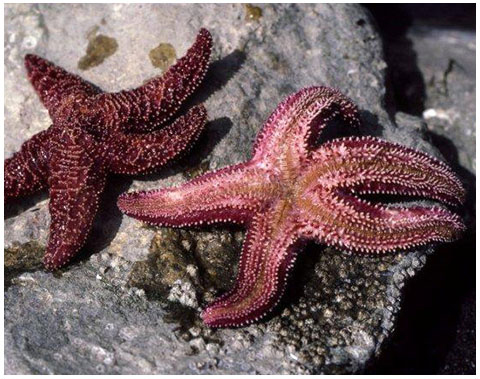
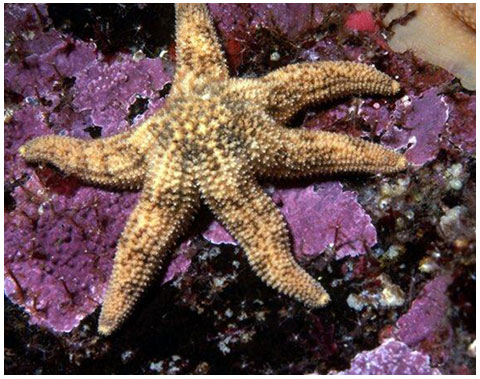
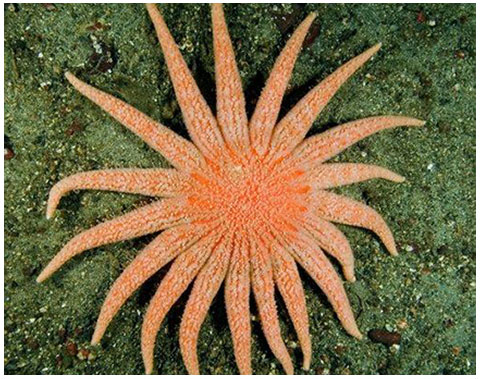
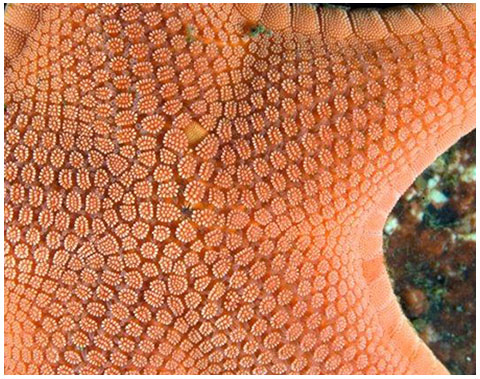
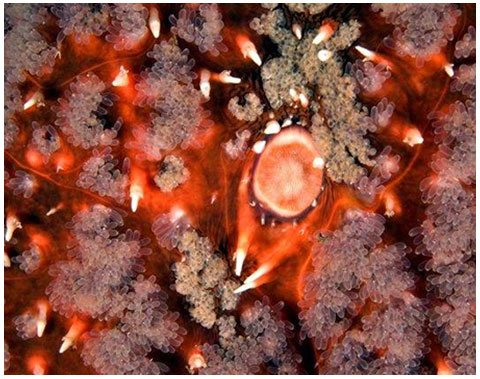
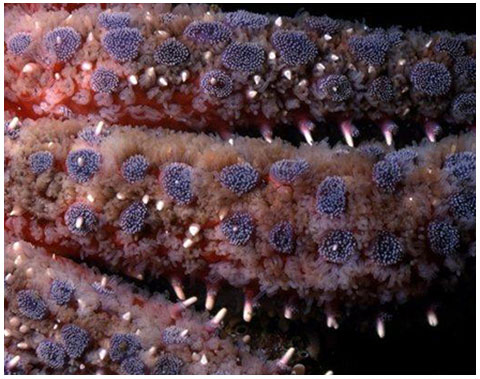
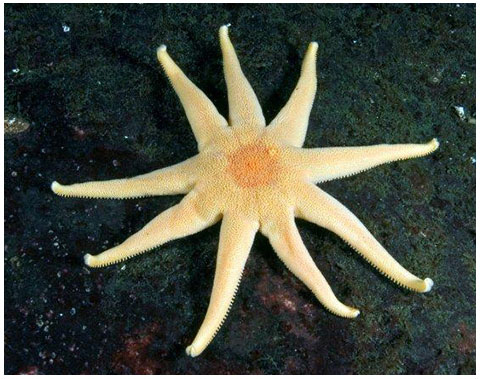
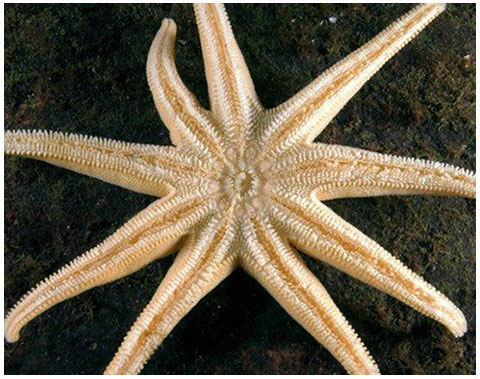

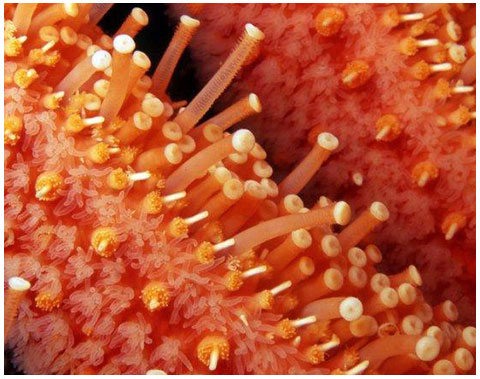
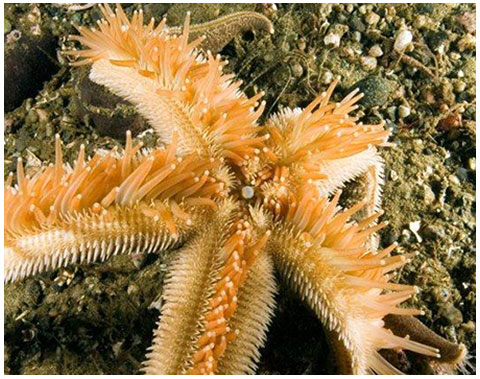
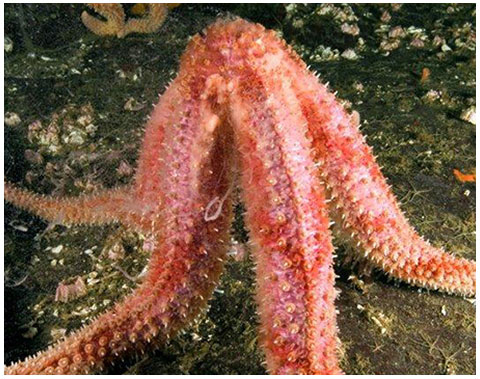
The PURPLE STAR is a "typical" 5-armed star demonstrating the radial symmetry characteristic of echinoderms.
Not all sea stars have 5 arms, however. Members of the genus Leptasterias normally have 6 arms.
There are sea stars with many arms, like the SUNFLOWER STAR. This one happens to have 18, but when it first settled from the plankton as a juvenile it started with only 5 arms.
The rigid skeleton of the VERMILION STAR is composed of thousands of tiny calcareous plates and granules.
The surface landscape of a SUNFLOWER STAR. Note the soft skin, circular madreporite, white spines and dense clusters of finger-like gills.
Pompoms of tiny blue pincers (pedicellariae) surround the white spines on the surface of this SUNFLOWER STAR.
The aboral (upper) surface of an ORANGE SUN STAR.
The oral surface: note the central mouth surrounded by spines and the ambulacral grooves where the tube-feet are situated.
Nearly hidden at the tip of this ORANGE SUN STAR'S arm is the red, light-sensitive eye-spot.
The tube-feet of a SUNFLOWER STAR. Note the suckers at the ends of the tube-feet, which are capable of great extension.
The tube-feet of a SAND STAR. Note the bluntly pointed tube-foot tips of this star which lives primarily on sand or mud substrates.
Streams of tiny eggs pour from the gonopores located in this female PAINTED STAR'S armpits. The eggs are fertilized by male sperm and develop into free-swimming larvae that eventually settle to the bottom.
6 - 12
Previous
NEXT
Your Comments & Questions Are Welcome
INTRODUCTION | ABOUT SEA STARS | BIOLOGY | SPECIES | PREDATORS / PREY | SEA STAR WASTING DISEASE | ACKNOWLEDGEMENTS | FIELD GUIDE | VIDEO
Copyright © 2018 All rights reserved.